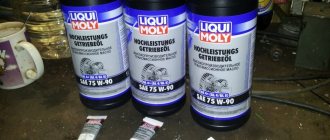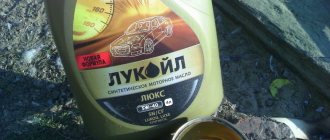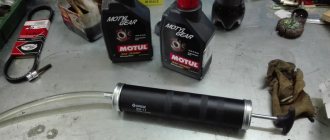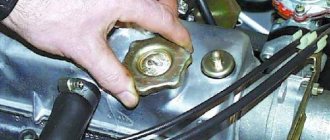- home
- Brands
- VAZ
29.09.2020
VAZ Niva (Lada 4x4) is a compact off-road vehicle, produced with a three- and five-door body. Production of the model began in 1977. In the 2010s, under the leadership of AvtoVAZ President Bo Andersson, an updated version of the Urban was developed with modified bumpers and improved finishing. In 2020, the car received a new front panel, adapted to modern safety and comfort requirements. However, the design remains the same. The original name “Niva” was relevant until 2006 in connection with the release of the more modern Chevrolet Niva SUV. However, in 2022, AvtoVAZ regained the right to use the Niva trademark, which previously belonged to the General Motors concern.
How much oil to fill in Niva
First generation 2121, since 1977
Despite the lightweight monocoque body and structural basis from the VAZ-2106, the Niva has impressive off-road capabilities largely due to its short wheelbase and almost non-existent body overhangs, which ensures high approach and departure angles. The car also has permanent all-wheel drive and is equipped with a transfer gearbox. Under the hood there is a non-alternative 1.7 petrol engine with a power of 81 hp. s., aggregated with a five-speed manual transmission. In 2016, AvtoVAZ improved the car's suspension - installed gas-filled shock absorbers and bearings in the front hubs, and also introduced independent mounting of the front axle gearbox. Since 2022, the car has been officially sold as Lada Niva.
- Transfer case oil: volume – 0.79 liters, tolerance and viscosity: API-GL-3-4; SAE 75W-90
- Rear axle gearbox oil: volume 1.3 liters; front - 1.15 liters; tolerance and viscosity: API-GL-3-4; SAE 75W-90
Also read: Engine oil for the VAZ 21213 Niva engine
Power unit
The engine installed on the modern model of the Niva 21213 (214) car was inherited from its Soviet progenitor - the VAZ 2121, and in terms of fluid volumes they are almost identical:
- Liquid cooling system. Filled with antifreeze in an amount of 10.7 liters with a freezing point not higher than -40 ° C. The capacity of the interior heating radiator is also included in this volume.
- Crankcase. Motor oils are poured here, the brand of which depends on the operating conditions. Capacity: 3.75 liters, including oil filter filling.
The viscosity of the oil poured into the Niva engine must correspond to the outdoor temperature at which the car is operated. Possible modes and suitable oil brands are shown in the table:
| Lower limit of ambient temperature, °C | -20 | -25 | -25 | -30 | -30 | -15 | -35 | -30 |
| Upper limit of ambient temperature, °C | +45 | +35 | +45 | +35 | +45 | +45 | +25 | 30 |
| SAE lubricant viscosity grade | 15W-40 | 10W-30 | 10W-40 | 5W-30 | 5W-40 | 20W-40 | 0W-30 | 0W-40 |
When flushing the power unit during the process of replacing liquid lubricant, the same amount of flushing oil (3.75 l) is used, taking into account the size of the filter. Replacement is carried out after 8-12 thousand kilometers, depending on the quality of the oil. Flushing is usually performed after 3 engine lubricant changes. During operation, it is important to monitor the oil level in the engine crankcase using a special dipstick. If the level drops below the Min mark, it is urgent to add lubricant to the engine of the same viscosity as was previously filled.
Antifreeze needs to be updated at least once every 3 years or according to the degree of wear of the fluid. It is not recommended to dilute antifreeze with distilled water, either in winter or summer. In winter, the diluted liquid may freeze, and during the summer heat it may boil ahead of time, which will lead to overheating of the engine.
What oil to use for VAZ Niva
Original
Three types of transmission oil are poured into the crankcase of the front and rear axles, as well as the transfer case of the VAZ Niva car - mineral, semi-synthetic or synthetic. For cars of recent years of production, semi-synthetic or synthetic is recommended. As for viscosity, SAE 70W, 80W or 85W is suitable for winter use, and SAE 90, 140 or 250 is used mainly in summer. Moreover, the most popular in the Russian environment is an all-season transmission with SAE 75W-80, 80W-85, 80W- 90 or 75W-90.
Unoriginal
To service the transfer case, gearbox and axles of a VAZ Niva, it is better to choose oil from trusted manufacturers - Mannol, Total, Eneos, ZIC, Castrol, Kixx, etc. Regarding the type of viscosity, it should be noted that synthetic oil is more fluid, suitable for cars of recent years release. Accordingly, mineral water or semi-synthetics are recommended for older cars. It has a relatively thick consistency, which means there is less chance of leaks in the presence of microcracks or gaps between contact pairs. Even when choosing an oil, pay attention to the current tolerance indicators API-GL-3, 4 or 5. The higher the indicator, the more oil additives. In the case of Niva, you can opt for API-GL-5. Below are suitable oils for the transfer case, axles and gearbox of the VAZ Niva.
- Liqui Moli 75W-90 GL-4/5
- Chevron 80W-90 GL-5.
Leaks and problems
The higher the mileage of the VAZ Niva, the more problems appear, as in principle with any car. Most often this is due to natural wear and tear of the engine, causing oil to burn. Although the manufacturer allows for a small consumption.
There can be many reasons why an engine eats oil. And in each case they can be individual. But, over the years of the model’s existence, we can talk about the most common places where leaks occur.
If the breather is spewing or throwing oil, or if there is oil in the exhaust manifold, this may indicate a serious problem with the oil rings. In this case, you can try decoking with dimexide. But it is better to use special auto chemicals designed for these purposes.
A leak from under the valve cover may be due to a worn gasket. Sometimes simply replacing the gasket does not solve the problem. Since the cover itself may have significant curvature. Therefore, in some cases it will have to be replaced.
A white emulsion in the engine or on the oil filler cap may indicate condensation. This is a common occurrence when temperatures change from minus to plus, mainly in autumn or spring.
But if the emulsion is also observed on the dipstick, then this is already a sign of more serious problems. Most often we can talk about a broken cylinder block gasket. And in rare cases, a cracked cylinder head may be to blame.
Also, with this problem, you can find oil in the expansion tank. Sometimes, simply replacing the gasket is not enough. It may be necessary to grind the head itself, and this is completely different money for repairs.
All this is general information, which may manifest itself differently on each specific vehicle, since everyone’s operating modes are different. The same applies to leak locations; it is impossible to identify the cause from a distance.
Tuning
The manufacturer used only one technique to increase engine power - increasing the piston stroke. Self-tuning will help you modify the 21214 engine to use its full potential (about 90 hp):
- boring of cylinders in the block - scheme 84/84 or 84/88 to obtain 1.9 liters and 2.0 liters (cylinder diameter/piston stroke, respectively);
- modification of the cylinder head - boring of channels up to 31 mm (exhaust) and 33 mm (intake), installation of a lightweight SHPG flywheel, Nuzhdin camshaft.
Thus, the injection version 21214 is superior to the basic modification of the carburetor engine. It has increased torque and power, and bends the valves with pistons when the single-row chain wears out.
If you have any questions, leave them in the comments below the article. We or our visitors will be happy to answer them
The need to change transmission oil
To change the oil on a Niva, the car must be warmed up (to ensure good fluid fluidity). The machine is placed on an inspection hole; a special container should be placed under the drain hole into which the waste liquid will drain. To open the drain and fill plug, you should use a hexagon. Also, as an additional tool, you will need a special syringe, which is used to fill the transfer case with fuel.
Changing the oil in the transfer case (Niva 21214 / 21213). Main stages:
- The drain plug is unscrewed.
- The remaining oil is poured into the container.
- Any contamination on the plug must be eliminated.
- The drain plug is screwed in.
- The top plug is unscrewed to fill in new oil using a syringe.
- The plug is screwed in.
The peculiarity of the gearbox is that it has a built-in magnet. Its function is to attract small metal debris that may be present in the fuel.
When replacing fuel, the crankcase must be flushed. This procedure helps to extend the operational life of the box. Flushing is required if the drained oil is heavily contaminated.
The frequency of changing fuel for the transmission is affected by the mileage of the Niva 21214 (21213) and the conditions under which it is used. When making frequent off-road trips, the need to change the oil for the transfer case and gearbox may arise up to 50,000 km.
The need to add a new lubricant to the box can be indicated by the fact that the gearbox began to overheat and characteristic noises appeared on its side during movement.
What cars was it used in?
Motor 21214 was used to equip several cars manufactured by AvtoVAZ:
- Lada Niva 4x4 (VAZ-21214) – three-door SUV;
- Lada 4x4 M - modernized version with power steering and ABS;
- Lada 4x4 5D (VAZ-213100) – an extended modification of a five-door SUV;
- “Ambulance” (VAZ-213145) – Euro-2/3 in small series;
- Lada Nadezhda (VAZ-2120) is a seven-seater all-wheel drive minivan.
Niva Lynx 4x4
The management did not consider it necessary to install it on the seven-seater Largus minivan. But in all modifications of the Niva 3- and 5-door (Bronto, Kedr, Pickup, Reka, Bys and armored collection vehicle) it was present.
Malfunctions, causes, elimination
Initially, engine 21214 has a characteristic failure - failure of 1 - 2 cylinders due to failure of the ignition module due to overheating. The coils and control switch burn out, and electrical equipment needs to be replaced. Other breakdowns are typical for most VAZ engines:
| At idle, the internal combustion engine is unstable and stalls. | 1) damage to the insulation of high-voltage wires 2) spark plug malfunction 3) valve timing failure 4) compression decreased | 1)replacement of high-voltage beams 2)adjusting the interelectrode gap, cleaning carbon deposits 3) installation according to shaft marks 4) valve grinding, cylinder repair |
| XX speed decreased spontaneously | 1) production of DXX | 1) replacing the idle speed sensor |
| The engine stalls while driving in the heat | 1) check valve stuck 2) the hose or tube is pinched 3) the drain line has failed 4) steam plug in the supply system | 1) valve replacement 2) inspection and correction of geometry 3) purging the line 4) purge and cleaning |
Hydraulic compensators eliminate the need for scheduled adjustment of valve clearances after 5–15 thousand kilometers.
Fuel and drain line
Advantages and disadvantages
The specified engine characteristics and its design have disadvantages:
- high noise during operation;
- very low service life;
- significant vibrations on the machine body;
- overheating of the engine in the urban cycle;
- high engine oil consumption.
As a result, frequent major repairs and an increased operating budget. The main advantages were:
- automatic chain tensioner;
- valve lifters;
All the problems of the classic series remain, however, with timely maintenance, the engine does not cause any special problems for the owner.
How to change the oil?
How to independently replace technological fluids in a Niva Chevrolet? To do this, you need to purchase high-quality oil, which is recommended by the manufacturer. All required volumes are indicated in the instructions for the car. For beginners, the replacement process will seem complicated, but in fact it is not.
The choice of oil for an all-wheel drive vehicle is a very important point; the service life, wear of parts and the operation of all transfer gear mechanisms depend on it. You need to buy liquids that are recommended by the manufacturer or proven, well-known brands. There are different types of oil for different seasons, they differ in viscosity and are adapted to work at a certain temperature.
If the car was purchased used, it is better to immediately check the level of all fluids and replace them.
Maintenance
The manufacturer AvtoVAZ recommends servicing the 21214 engine on your own or at a service station according to the following schedule:
- the oil and filter are updated annually or after 7.5 - 10 thousand mileage;
- the chain has a high resource of 200 thousand, but is regularly monitored for stretching/tension;
- the fuel and air filters become unusable after 20 - 30 thousand mileage;
- spark plugs and batteries are usually enough for 60 - 70 thousand km;
- It is recommended to update the cabin filter annually, regardless of the car's mileage.
Initially, the internal combustion engine design was simpler, but it was necessary to periodically adjust the erroneous settings of the valve thermal clearances. Then the modernization added hydraulic pushers to the timing belt design, saving the user from this operation and monthly expenses.
Modifications
Since 1994, the manufacturer has adjusted the parameters of motor 21214 several times:
- 21214-10 (2002) – Euro-0, the first version had central gasoline injection;
- 21214-20 (2006) – Euro-2 controller Bosch MP 7.0, pairwise variable injection;
- 21214-30 (2008) – Euro-3, without power steering;
- 21214-41 (2011) – Euro-4 for the Russian Federation and Euro-5 for export, power steering, welded manifold;
- 21214-22 – Euro-2, hydraulic supports for valve levers appeared;
- 21214-31 – Euro-3, welded steel manifold, power steering pump;
- 21214-32 – Euro-3, power steering, cast iron manifold, flywheel for 215 mm clutch diameter;
- 21214-33 – Euro-3, cast iron manifold, hydraulic booster;
- 21214-34 – Euro-3, cast manifold without power steering.
All versions from the factory had INA hydraulic mounts, with the exception of version 21214-41, which was equipped with YAZTA hydraulic mounts.
Power steering 21214
Modification 21214-28 had a volume of 1.8 liters due to the larger piston stroke of 84 mm. The engine power reached 92 hp. s., and the torque is 159 Nm. In total, a little more than 69 engines of this type were produced.
Design Features
Initially, the 21214 engine was developed for distributed injection, that is, for an injector. It was planned to ensure an environmentally friendly standard, which was carried out successfully - during the finalization process, the internal combustion engines had Euro-2 - Euro-4, and for the export versions of Niva and Nadezhda, even Euro-5.
The main feature of 21214 was the factory boost:
- injector instead of carburetor;
- modified cylinder head (hydraulic pushers);
Hydraulic support ramp (bottom)
In turn, this required improvement of other designs:
- the volume of engine oil has increased, the pump sprocket now has 30 teeth to increase its performance;
- the double-row chain is replaced by a roller-type single-row modification to drive attachments and the timing camshaft;
- The camshaft cams have changed shape.
Design 21214
Upgraded chain tension system:
- the spring creates pre-tension when the engine is off;
- After starting, pressure is created in the system, the tension is regulated by hydraulics.
Hydromechanical chain tensioner
The manufacturer has provided additional do-it-yourself tuning due to the +50 hp potential built into the design. With. Overhauling the simplest internal combustion engine design does not cause any problems, including in a garage on your own.
Bosch 0280158110 injectors were first installed on the fuel rail, then yellow Siemens VAZ 20734. The ignition has a modular design with Bosch MP 7.9.7 and January 7.2 controllers. Pair-parallel injection provides Euro-2, phased injection – Euro-3.
Other liquids and fuels and lubricants
Every car enthusiast should know by heart the maximum fuel capacity of his car. The fuel tank of the VAZ 21213 has a capacity of 42 liters, including reserve. The reserve refers to the amount of fuel remaining in the tank after the yellow warning light on the instrument panel turns on. The reserve amount is at least 5 liters. The car must be fueled with gasoline whose octane number is in the range of 91-93.
The car has a number of refueling tanks that the owner must monitor during operation:
- brake system with expansion tank, total capacity - 0.515 l;
- hydraulic clutch drive with expansion tank - 0.2 l;
- 2 plastic tanks with a volume of 2 liters each contain a supply of windshield and rear window washer fluid.
The clutch release drive and brake system are filled with hydraulic brake fluid (the most popular is DOT-4). It should be changed at least every 3 years, because the liquid has the ability to absorb water vapor contained in the air. As a result, all steel parts of the system in contact with it begin to corrode, which leads to complete or partial failure of the brakes.
If there is a leak in the clutch or brake system, the level in the expansion tanks decreases, so constant monitoring is required over them.
The level of brake fluid in the reservoirs must be maintained no lower than the corresponding mark on the plastic body of the container.
Liquid or clean water for washing glass is added if necessary; in winter, a non-freezing option is required. Otherwise, the ice will not only destroy the tubes, but also damage the electric pump.
Various thick lubricants are also used for maintenance and lubrication of the Niva:
- Litol - a composition for lubricating highly loaded bearing parts;
- CV joints-4 - lubricant for the hinges of the front axle shafts and door opening limiters;
- ShRB-4 is designed for processing ball joints and steering rods.
The list of refueling containers is useful for novice car enthusiasts who bought a used car with a lost instruction manual. The operation of such a car should begin with the replacement of all fluids and oils.











